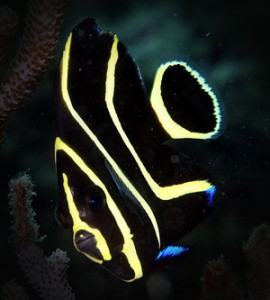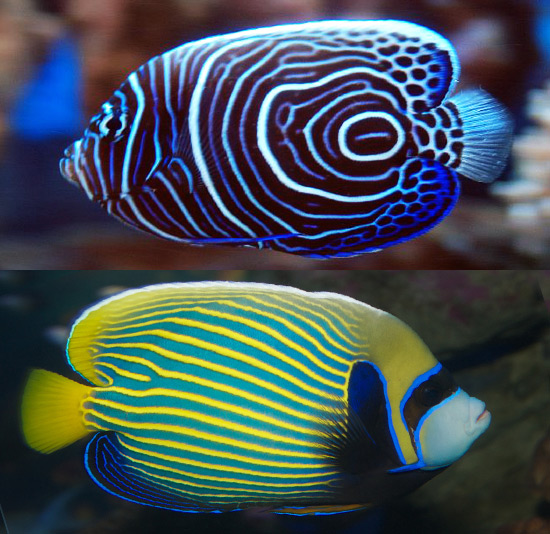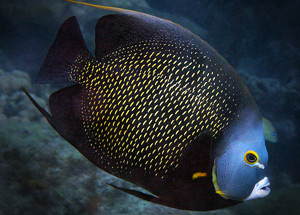When human parents bring a child into the world, they watch their offspring eagerly for facial features and other physical characteristics that are similar to their own. Moms and dads experience a certain pride whenever someone acknowledges that, “She has her mother’s eyes” or “He has his father’s smile.”
But in the world of reef fishes, it’s not always helpful for youngsters to be a “chip off the old block” appearance-wise. In fact, it can sometimes be extremely beneficial for juveniles to look nothing like their parents. Such is the case with many of the marine angelfishes. For instance, juveniles of the Pomacanthus and Holacanthus genera often sport coloration and patterning so different from that of adult conspecifics that they can easily be mistaken for different species altogether.
How different?
Take the iconic emperor angelfish (Pomacanthus imperator) for example. While the adults exhibit alternating yellow and blue horizontal stripes on their sides; white, black, and yellow coloration around the head (including a “raccoon mask” across the eyes); and a bright-yellow tail fin, the juveniles have a dark blue to black base color with light-blue to white lines forming vertical stripes and concentric circles on their flanks.
Another example (for “Caribbean Chris’s” edification) is the French angelfish (Pomacanthus paru). Adults of this species are black overall with gold-flecked scales and a grayish face. The juveniles are also black, but they differ markedly from the adults in that they have yellow vertical, curving bands on their flanks.
And there are many other examples of similar adult/juvenile differences among the marine angels. But why do the adults and juveniles differ to such an extent?
Familiarity breeds contempt
Remember, many coral reef fishes view similarly colored, shaped, or patterned fishes as direct competition for food, territory, and reproductive opportunities. Thus, looking nothing like adults of their species (and sometimes having a different diet from their adult conspecifics, as well) increases the odds that juvenile angelfishes will be tolerated within the confines of an adult’s range—which can be quite extensive—without raising anyone’s hackles.
Some juvenile angels are cleaners
I mentioned above that juvenile angels sometimes have a different diet from that of adult conspecifics. One manifestation of this is the tendency of certain species to act as cleaners of other fish in the juvenile phase. This tendency has been well documented in, among others, juvenile French angels and gray angels (Pomacanthus arcuatus).
The habit of cleaning has survival value not only in the sense that it helps satisfy the juveniles’ nutritional needs, but it also may afford them a certain degree of protection. The patterning and contrasting coloration that is so similar among the juveniles of many different angelfish species may “advertise” to other fishes that they’re in the “cleaning business,” so perhaps predators will be less inclined to view them as a potential meal.





